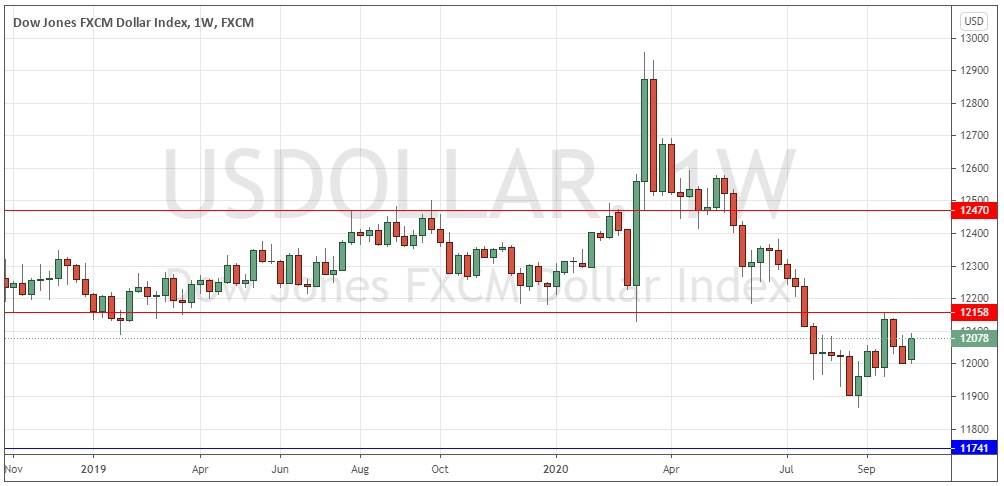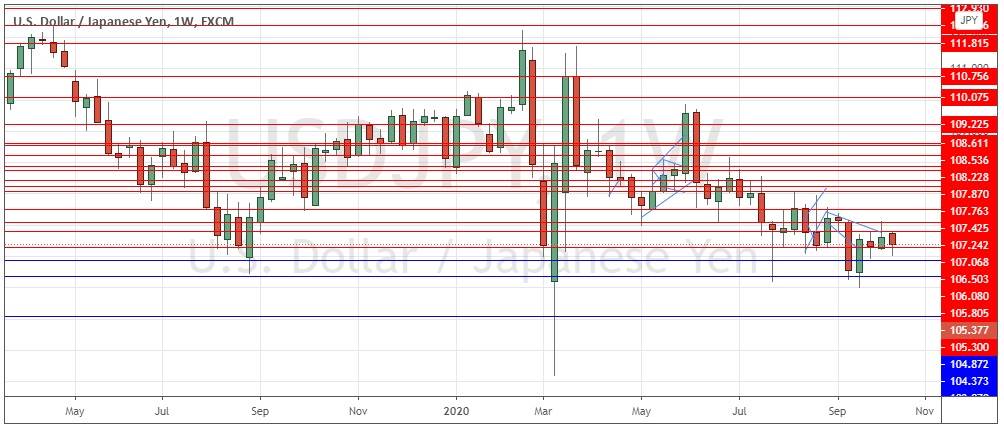The difference between success and failure in Forex trading is very likely to depend mostly upon which currency pairs you choose to trade each week and in which direction, and not on the exact trading methods you might use to determine trade entries and exits. The current market environment remains one of contradiction, with a questionable rebound as global stock market indices recovered to reach new all-time highs before correcting, despite the continuing spread of the coronavirus pandemic which is still sweeping the world.
Big Picture 18th October 2020
In my previous piece last week, I saw the most attractive trade opportunities as likely to be in short-term short trades in the USD/JPY currency pair and short-term long trades in the S&P 500 Index. This was an indifferent call as the USD/JPY currency pair ended the week down by 0.21% and the S&P 500 Index ended the week down by 0.48%.
Last week’s Forex market saw the strongest rise in the relative value of the Japanese Yen and the strongest fall in the relative value of the Australian Dollar.
Fundamental Analysis & Market Sentiment
The focus now of stock market analysts in the U.S. is centered mostly upon the issue of progress towards a deal between House Democrats and the Trump administration on a further round of economic stimulus which is widely seen as necessary to reignite economic recovery from the coronavirus shock earlier in the year. It seems clear that there will be no such agreement before the election, but opinion polls are suggesting that a Democrat clean sweep of the Presidency and both Houses of Congress is becoming increasingly likely, which would probably result in a generous and fast stimulus package being agreed rapidly, and this is holding markets up despite the general shakiness of risk sentiment.
Markets appear to be largely unconcerned with the result of the U.S. Presidential election, having already priced in a likely Biden victory which is forecast by all major opinion pollsters. Nationwide polls are showing Biden ahead by almost 10%, while in the key states he is ahead by about 6%. Some analysts take a contrarian view that the polls severely underestimate the President’s support. Betting markets are increasingly predicting a more comfortable Biden victory with a probability of about 66%, and markets seem quite comfortable with that.
The U.S. stock market went sideways last week.
Last week saw stronger than expected U.S. retail sales data, and a seeming collapse in talks between the U.K. and the E.U. on a final Brexit trade deal. However, Forex markets were mostly quiet, with no really notable moves in any of the currencies relevant to this news.
The government of New Zealand was re-elected with a landslide victory this weekend, so we may see some unusual movement in the New Zealand Dollar when Forex markets resume trading for this week.
It is becoming clearer that globally, the amount of new confirmed coronavirus cases is increasing exponentially. Last Friday saw a new record high daily tally, with 413,175 confirmed cases reported.
There has been a strong rise in new daily cases within the European Union and the United Kingdom over recent days, with the strongest increases in new cases now being seen in Europe. This is leading several European countries to again impose restrictions aimed at slowing the spread of the virus, most notably this weekend with the imposition of a curfew in nine French cities shortly after the U.K. has imposed new localized lockdown measures. The European Union is now reporting more daily cases than any single country. New cases are also rising strongly in the U.S.A. to hit levels not seen since July.
Yesterday saw the highest daily coronavirus death toll in India, at just over 1,000 deaths.
Latin America is responsible for approximately 31% of confirmed new daily deaths, with India at 19%, the U.S.A. at 13% and Europe (including the U.K.) at about 18%. The strongest growth in new confirmed cases is happening in Albania, Andorra, Argentina, Armenia, Austria, Azerbaijan, Belarus, Belgium, Bosnia, Bulgaria, Canada, Costa Rica, Croatia, Cyprus, Czech Republic, El Salvador, Finland, France, Georgia, Germany, Greece, Hungary, Iran, Ireland, Italy, Jordan, Kenya, Kosovo, Kuwait, Latvia, Lebanon, Lithuania, Luxembourg, Malaysia, Malta, Moldova, Montenegro, Morocco, Nepal, Netherlands, North Macedonia, Poland, Portugal, Romania, Russia, Serbia, Slovakia, Slovenia, Spain, Sweden, Switzerland, U.S.A., Ukraine, the U.A.E., and the United Kingdom.
The coming week is likely to bring a somewhat higher level of activity in the Forex market than what was seen last week. We will be getting Chinese GDP, British, Canadian, and New Zealand inflation data, French and German economic activity surveys, and the Reserve Bank of Australia’s Monetary Policy Meeting Minutes.
Technical Analysis
U.S. Dollar Index
The weekly price chart below shows the U.S. Dollar index printed a bullish engulfing candlestick. It closed quite near the high of its range, which is a bullish sign, although there is still a long-term bearish trend, as the price is lower than it was both 3 and 6 months ago. Overall, next week’s price movement in the U.S. Dollar looks unpredictable, and it should be noted that for several weeks now the U.S. Dollar has been unable to fall significantly and is showing signs of recovery.
USD/JPY
The USD/JPY currency pair is in a long-term downwards trend and fell slightly last week, albeit with a weakly bearish candlestick with a lower wick. The Dollar itself is still technically in a downwards trend yet few currencies currently look strong against it. The bearish trend here is slow but persistent. A further fall over the coming week is more likely than not to happen. The problem with shorting the U.S. Dollar against other currencies right now is that there are few strong currencies that are not close to firm long-term resistance or support levels which may well block further strong movement in the near term.
Bottom Line
I see the best likely opportunities in the financial markets this week in looking for short-term short trades in the USD/JPY currency pair or against other relatively weak currencies such as the Euro or British Pound.


